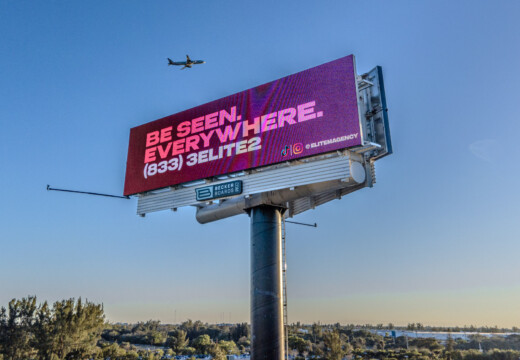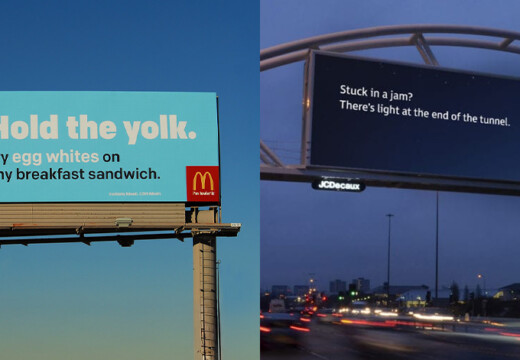Setting objectives for billboard ads ensures your campaigns deliver measurable results. Here’s how to get started:
- Align Objectives with Business Goals: Match your billboard strategy to goals like brand awareness, sales growth, or promoting a new location.
- Know Your Audience: Target ads based on geography, traffic patterns, and audience behavior.
- Set SMART Goals: Make objectives specific, measurable, achievable, relevant, and time-bound.
- Example: "Increase store visits by 20% in 3 months using billboards near high-traffic areas."
- Track Key Metrics: Use KPIs like impressions, QR code scans, or foot traffic to measure success.
- Leverage Real-Time Data: Adjust campaigns based on performance insights, such as peak hours or location effectiveness.
Start small – budgets can begin at $20 – and refine as you go. With clear goals and data-driven decisions, billboard ads can drive real results.
Align Business Goals with Billboard Campaigns
Match Business Goals to Ad Objectives
To make your billboard campaigns truly effective, they need to align with your specific business goals. Digital billboards, in particular, offer flexibility and versatility to help achieve a range of objectives – from increasing brand awareness to driving foot traffic for location-based promotions.
Here’s how you can pair your business goals with the right billboard strategy for maximum impact:
| Business Goal | Billboard Strategy |
|---|---|
| Brand Awareness | Place ads in high-traffic areas with bold, unforgettable messaging to grab attention. |
| New Location Launch | Use targeted displays near your new venue, including clear directional information. |
| Market Differentiation | Showcase creative designs that emphasize your unique selling points. |
| Sales Growth | Position billboards along key routes leading to your business locations. |
Businesses that align their advertising strategies with their core objectives often see impressive returns. By focusing on the right audience and locations, you can make your campaigns not only visible but also impactful.
Know Your Target Audience
A great example of understanding and targeting the right audience comes from Pretty In Pinkston. Owner Kimberly Pinkson highlights how billboards helped her business stand out:
"Blip works for us. It’s a different medium, and it brings a lot of exposure. It sets us apart from the rest of the [competition], and that’s what I like."
When identifying your target audience, focus on these key factors:
- Traffic Patterns & Geography: Pinpoint high-traffic areas and times where your ideal customers are most likely to see your ads.
- Audience Behaviors: Time your billboard displays to align with the daily routines of your target demographic.
- Message Relevance: Craft messages that directly resonate with the specific needs and interests of your audience.
Another success story comes from Hashtag-Vape. Founder Ray Bowens shares how billboards helped his business thrive:
"Billboards are one of the most impactful ways to advertise, and with Blip, you spend a fraction of what you would end up paying elsewhere."
The secret to effective billboard campaigns lies in aligning your advertising strategy with your business goals while keeping a sharp focus on your audience. When done right, outdoor advertising can deliver results that not only meet but exceed your expectations.
Planning an Advertising Campaign: Campaign Objective and Budget
Set SMART Billboard Objectives
Once you’ve aligned your billboard strategy with your business goals and target audience, it’s time to refine your approach with SMART objectives. These objectives help ensure your billboard campaign delivers measurable results and maximizes ROI.
Make Goals Specific and Measurable
Broad goals like "increase brand visibility" are too vague to track effectively. Instead, break them down into specific, measurable targets. For instance, instead of just aiming for visibility, you could set goals like "reach 100,000 daily impressions" or "drive 500 website visits via QR code scans."
| Goal Type | Example Metric | Measurement Method |
|---|---|---|
| Brand Awareness | Daily Impressions | Traffic count data |
| Store Traffic | Foot Traffic | Door counter comparison |
| Online Engagement | QR Code Scans | Landing page analytics |
| Sales Growth | Revenue Increase | Point-of-sale data |
Once you’ve established these measurable goals, you can tailor them to fit your campaign budget and resources.
Set Realistic Goals Within Budget
Your objectives need to reflect what’s achievable within your financial and logistical limits. To keep your goals realistic, factor in:
- Daily advertising spend: Determine how much you can allocate without overextending.
- Audience reach potential: Understand the size and demographics of your target audience.
- Peak visibility hours: Identify the times when your billboard will get the most attention.
- Location-specific performance: Consider how the billboard’s placement impacts its effectiveness.
Set Campaign Timelines
Defining a clear timeframe for your campaign is essential for monitoring progress and evaluating success. When setting your timeline, keep these points in mind:
- Align with peak seasons: Schedule your campaign during periods of high consumer activity.
- Allow for performance tracking: Give yourself enough time to gather meaningful data.
- Ensure sufficient duration: Make sure the campaign runs long enough to meet your objectives.
"Billboards are one of the most impactful ways to advertise, and with Blip, you spend a fraction of what you would end up paying elsewhere".
With these timelines and objectives in place, you’ll be ready to transition into tracking results through your chosen KPIs.
Choose KPIs to Track Results
Choosing the right KPIs is essential for measuring your campaign’s success and ensuring they align with your business goals.
Key Billboard Metrics
Different objectives call for different ways to measure success. Here’s a quick guide to matching your goals with the right KPIs:
| Campaign Objective | Primary KPIs | Secondary KPIs |
|---|---|---|
| Brand Awareness | Daily Impressions, Reach | Average Frequency, Peak Hour Performance |
| Lead Generation | Website Visits, QR Code Scans | Conversion Rate, Cost Per Lead |
| Store Traffic | Foot Traffic Increase, Sales Lift | Customer Attribution, Peak Visit Times |
| Event Promotion | Ticket Sales, Event Attendance | Registration Timeline, Geographic Response |
For example, if your goal is to drive traffic to a retail store, tracking impressions alongside in-store foot traffic can help reveal how billboard exposure influences customer visits. Focus on metrics that directly tie to your desired outcomes for a clearer picture of campaign impact.
Once your KPIs are set, the next step is monitoring how your campaign performs in real time.
Monitor Campaign Performance
Blip’s analytics dashboard provides real-time insights to help you make smart, data-driven decisions. Here are some of its key features:
- Daily Performance Tracking: Keep tabs on impressions and plays across various locations.
- Cost Analysis: Evaluate CPM rates and track how your budget is being spent.
- Peak Time Performance: Identify the hours when your campaign gets the best response.
- Location Effectiveness: Compare how different billboard spots are performing.
With Blip’s real-time bidding system, updated every 10 minutes, you can quickly adapt your strategy based on the latest data. Regularly reviewing your KPIs and setting thresholds for adjustments ensures your campaign stays on track and within budget.
sbb-itb-2e2e93f
Improve Campaigns with Data
Make Real-Time Campaign Updates
Using real-time analytics can take your billboard campaigns to the next level. Blip’s bidding system lets you adjust on the fly, ensuring your ads perform as effectively as possible. Here’s how to make the most of real-time data:
- Keep an eye on how different locations are performing and adjust your budget to focus on the best spots.
- Adapt your daily spending based on performance trends to maximize results.
"Working with Blip has given Mr. Charlie’s the momentum to get our new location on the map while accelerating growth for our original location", shares Paul Willey, Owner of Mr. Charlie’s Chicken Fingers.
These insights don’t just guide immediate changes – they also shape future creative strategies.
Test Different Ad Designs
One of the perks of digital billboards is the ability to test multiple ad designs. When experimenting, prioritize these factors:
Visual Impact and Message Clarity
- Use bold, high-contrast visuals that align with your brand colors.
- Keep your message simple and readable within 8 seconds.
- Include a clear call-to-action and essential contact details.
- Highlight what makes your product or service stand out.
"It’s not a social media thing that you see on your phone. It’s not word-of-mouth. It’s big and bold and out there in public. I would say this is the first step of looking big and public", explains Chris Leslie, Founder of Leslie Lightcraft Co.
By refining your creative approach and analyzing the results, you can create even better campaigns moving forward.
Learn from Past Campaigns
Your past campaigns are a goldmine of information. Use this data to fine-tune future strategies by focusing on these metrics:
| Analysis Area | What to Track | How to Apply |
|---|---|---|
| Audience Response | Peak engagement times | Schedule future ads during the hours with the highest engagement. |
| Location Impact | Performance by area | Focus on billboards in locations that show the strongest return on investment. |
| Design Elements | Most effective visuals | Reuse successful design elements in your next round of campaigns. |
Conclusion
Setting clear objectives is the cornerstone of creating effective billboard campaigns and measuring their success. As digital billboard advertising becomes more accessible, businesses have greater opportunities to meet their marketing goals.
Ray Bowens of Hashtag-Vape highlights this advantage, saying:
"Billboards are one of the most impactful ways to advertise, and with Blip, you spend a fraction of what you would end up paying elsewhere".
To make the most of your billboard campaigns, consider these key strategies:
- Align your goals with measurable objectives: Ensure your campaign’s purpose is clear and tied to specific outcomes.
- Leverage real-time data: Use analytics to refine and improve campaign performance on the go.
- Get creative while maintaining visibility standards: Experiment with designs that grab attention while adhering to best practices.
- Track and analyze metrics: Measure ROI to understand your campaign’s impact and inform future decisions.
FAQs
How can I track the success of my billboard advertising campaign?
When running a billboard campaign with Blip, you get access to comprehensive analytics that make tracking your campaign’s performance straightforward. You’ll be able to monitor key metrics like impressions and costs, giving you a clear picture of how well your ads are meeting your goals.
Blip’s user-friendly tools also let you fine-tune your campaign based on real-time data. This means you can make informed adjustments on the fly, ensuring your advertising dollars are working as efficiently as possible.
How do I choose the best locations for my billboard ads?
Choosing the Best Locations for Your Billboard Ads
Picking the perfect spots for your billboard ads can make all the difference in how well they perform. Begin by focusing on areas where your target audience is most likely to encounter them. Think major highways, bustling intersections, or spots near businesses that align with your message. Pay attention to factors like traffic flow, local demographics, and how easy it is to spot your ad to ensure you’re reaching the right crowd.
Platforms like Blip make this process even simpler. They let you browse available billboard locations and provide helpful metrics, such as impressions and cost-per-thousand (CPM), so you can make informed choices. Plus, this kind of flexibility means you can experiment with different areas and fine-tune your approach to get the most out of your campaign.
How can I use real-time data to optimize my billboard ad campaigns?
Real-time data is an incredibly effective way to fine-tune your billboard advertising strategy. By diving into metrics such as impressions, audience engagement, and geographic performance, you can pinpoint the locations, times, and messages that connect best with your audience. This allows you to tweak your campaign settings to get the most out of your investment.
Platforms like Blip simplify this process with advanced analytics and real-time bidding features. You can track how your campaign is performing, experiment with different strategies, and allocate your budget more wisely. Plus, you’ll ensure your ads show up at the right time and place to make the biggest impact. This data-driven method keeps your campaign flexible and helps you hit your advertising goals effectively.
When running a billboard campaign with Blip, you get access to comprehensive analytics that make tracking your campaign’s performance straightforward. You’ll be able to monitor key metrics like impressions and costs, giving you a clear picture of how well your ads are meeting your goals.
Blip’s user-friendly tools also let you fine-tune your campaign based on real-time data. This means you can make informed adjustments on the fly, ensuring your advertising dollars are working as efficiently as possible.
"}},{"@type":"Question","name":"How do I choose the best locations for my billboard ads?","acceptedAnswer":{"@type":"Answer","text":"
Choosing the Best Locations for Your Billboard Ads
Picking the perfect spots for your billboard ads can make all the difference in how well they perform. Begin by focusing on areas where your target audience is most likely to encounter them. Think major highways, bustling intersections, or spots near businesses that align with your message. Pay attention to factors like traffic flow, local demographics, and how easy it is to spot your ad to ensure you're reaching the right crowd.
Platforms like Blip make this process even simpler. They let you browse available billboard locations and provide helpful metrics, such as impressions and cost-per-thousand (CPM), so you can make informed choices. Plus, this kind of flexibility means you can experiment with different areas and fine-tune your approach to get the most out of your campaign.
"}},{"@type":"Question","name":"How can I use real-time data to optimize my billboard ad campaigns?","acceptedAnswer":{"@type":"Answer","text":"
Real-time data is an incredibly effective way to fine-tune your billboard advertising strategy. By diving into metrics such as impressions, audience engagement, and geographic performance, you can pinpoint the locations, times, and messages that connect best with your audience. This allows you to tweak your campaign settings to get the most out of your investment.
Platforms like Blip simplify this process with advanced analytics and real-time bidding features. You can track how your campaign is performing, experiment with different strategies, and allocate your budget more wisely. Plus, you’ll ensure your ads show up at the right time and place to make the biggest impact. This data-driven method keeps your campaign flexible and helps you hit your advertising goals effectively.
"}}]}


